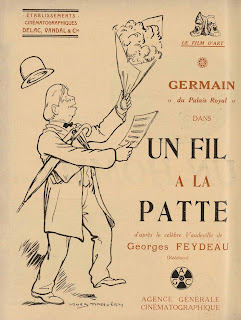A play by Feydeau
We are reminded on September 22, 1923 that Georges Feydeau had already written for the cinema. For this adaptation, the screenplay had to be submitted to him. His death in 1921 will condemn this initiative, but not the project which, it seems, was to be called "A good fortune", a title quickly forgotten to take advantage of that of the popular original work of which here is the adapted plot :
Armand de Bois-d'Enghien wants to marry the daughter of Baroness Duverger but has to get rid of his thread: his mistress, the music-hall artist Lucette Gautier. She arrives at the wedding and the scandal breaks out.
A role for Maurice Chevalier
Comoedia of October 20, 1923 tells us that Armand Bernard is interposing between À la Gare and Un fil à la Patte (A Fly in the Ointment), a shoot for Théo Bergerat: Mimi Pison.
Following the success of the actor's stage performances, the authors Georges de La Fouchardière and Félix Celval also wrote a second comedy sketch for Planchet, "The real boy". He's supposed to present it within a month.
Un fil à la Patte is therefore the third and last film that Robert Saidreau and Armand Bernard will shoot for Productions Diamant, the company of Henri Diamant-Berger, and as for the two previous ones, we find all the actors under contract of the firm: Marcel Vallée, Louis Pré-Fils, Charles Martinelli and of course Armand Bernard. But in 1923, the big star of Films Diamant, who had already shot and released comedies for the firm just that year, was a young singer who was a success in Parisian operettas: Maurice Chevalier. And quite logically, an interview with Maurice Chevalier in Ciné pour tous on May 4, 1923 reveals that it was he who was at the time expected to be the star of the film!
No doubt his schedule at the time did not allow a sixth film, and the new star of Films Diamant, in a very different genre, thus advantageously replaced the young matinee idol in the person of Armand Bernard.
Saidreau has also not forgotten one of his comrades, the actor Germain, the star who played Bouzin in the previous adaptation, as well as "in all the works of Feydeau" at the Nouveautés Theater as we learn from the Intransigeant of February 2 1924, and which he hires to also appear in this version. In Le Petit Marseillais of February 12, Germain considers that at the time he had become almost voiceless, which is not a problem for the silent art, recalls Saidreau, who seems to be doing a good deed here with a colleague going through hard times.
Marcelle Yrven is here a 46-year-old "debutante". Yanne Exiane is shooting here for the first time with Saidreau, but will again in Jack. Suzy Renard, of the Comédie Française, seems to play her last role on the screen here despite her young age. Comoedia completes the cast list on January 20, 1924: Suzy Pierson, Andrée Warneck and Gaby Brun.
 |
| Suzy Renard |
Shooting
Comoedia announces that the assembly was completed on January 20, 1924 (undoubtedly it concerns the interiors only) and specifies that the operator is Alfred Guichard.
Release and critic
Although less compared to the previous film, the delay between the end of filming and the release of this production is unusually long. But unlike the film At the station, the wait here is not in vain: the film is released at the prestigious Gaumont Palace on April 24, 1925. Critics point to this delay on
May 18, 1925 "this already old film is not Saidreau's best. It is not entirely his fault that it seems very gray to us". It seems that at a time when cinematographic storytelling techniques are evolving rapidly, a film made almost a year and a half ago is showing its age.
Among the films of the week in Cinémagazine of April 24, 1925, "the Friday regular" tells us about the film in a flattering light, although he names the director "Pierre" Saidreau. "We're having fun with the avatars of the heroes of the story and the misadventures of the unfortunate Bouzin. We go behind the scenes of a music hall in the corners of Paris where we appreciate a homogeneous interpretation composed by Germain, Marcel Yrven, Suzy Renard and Armand Bernard. "
Overall, the reviews are good: Le Matin retains "a well-sustained pace which reveals the technical mastery of Robert Saidreau." Le Journal sums up: "The whole thing could not displease and the technique remains irreproachable."
One fact is worth noting though: I couldn't find any photos of the film anywhere, either during filming or upon release. At a time when there are many magazines and illustrated newspapers dedicated exclusively to cinema, this is an additional piece of the puzzle of why Saidreau remains, until today, an illustrious stranger.
To read the next chapter on the work of director Robert Saidreau, click here.
Click "Like" on the Facebook page if you like my blog.
That's all for today folks! See you soon !
